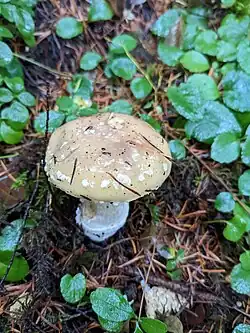Amanita pantherinoides
| Amanita pantherinoides | |
|---|---|

| |
| Scientific classification | |
| Kingdom: | Fungi |
| Division: | Basidiomycota |
| Class: | Agaricomycetes |
| Order: | Agaricales |
| Family: | Amanitaceae |
| Genus: | Amanita |
| Species: | A. pantherinoides
|
| Binomial name | |
| Amanita pantherinoides Murrill (Murrill)
| |
| Synonyms[1] | |
| |
| Amanita pantherinoides | |
|---|---|
| Gills on hymenium | |
| Cap is convex or flat | |
| Hymenium is adnexed | |
| Stipe has a ring and volva | |
| Spore print is white | |
| Ecology is mycorrhizal | |
| Edibility is poisonous or psychoactive | |
Amanita pantherinoides, commonly known as the western panther[2] or western American false panther[3] is a species of mushroom in the family Amanitaceae. It is poisonous, containing ibotenic acid and muscimol.[4][2]
Taxonomy
Amanita pantherinoides has long been thought to be the same as the nearly identical-looking Amanita pantherina, but it is now considered to be a distinct species.[2] A. pantherina occurs in Europe and eastern North America, while A. pantherinoides occurs in western North America.[4]
Description
Amanita pantherinoides has a light brown cap that is about 4–10 cm (1.6–3.9 in) wide.[2][4] The cap has white warts that sometimes wash off.[2] The stipe is about 5–12 cm (2.0–4.7 in) tall and about 1–2 cm (0.39–0.79 in) wide.[2] The mushroom has a ring and a volva.[2]
Habitat and ecology
Amanita pantherinoides is mycorrhizal and grows under conifers, especially Douglas fir. It is usually found in forests, but occasionally cities as well.[2]
References
- ^ "Amanita pantherinoides". Catalogue of Life. Species 2000: Leiden, the Netherlands. Retrieved 21 October 2024.
- ^ a b c d e f g h Siegel, Noah; Schwarz, Christian (September 1, 2024). Mushrooms of Cascadia: A Comprehensive Guide to Fungi of the Pacific Northwest. Humboldt County, CA: Backcountry Press. p. 52. ISBN 9781941624197.
- ^ "Amanita pantherinoides - Amanitaceae.org - Taxonomy and Morphology of Amanita and Limacella". www.amanitaceae.org. Retrieved 2024-10-20.
- ^ a b c "Amanita pantherinoides – Mushrooms Up! Edible and Poisonous Species of Coastal BC and the Pacific Northwest". explore.beatymuseum.ubc.ca. Retrieved 2024-10-20.